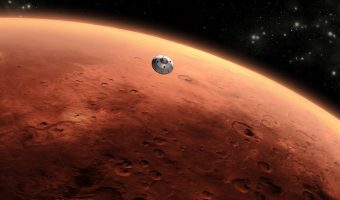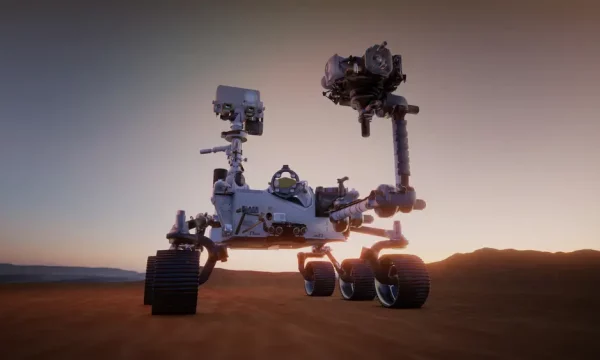
How Long Did It Take Perseverance To Get To Mars?
Last Updated: May 24, 2022
Humanity has launched 48 missions to Mars with variable success rates. The most recent of these was the Mars 2020 Perseverance Rover. How did it get to Mars, how long did it take to get there and what is it doing there?
The rover
The Perseverance Rover is a car-sized robot weighing 2,260 pounds (1,025 kilograms) and having the following dimensions: 10 feet long (not including the arm), 9 feet wide, and 7 feet tall (3 meters long, 2.7 meters wide, and 2.2 meters tall).
The Rover’s body (or warm electronics box) protects its computer and electronics in a temperature-controlled environment. Its computer brain (or Rover Compute Element, RCE) directs the Rover’s instruments and exchanges commands and data with Earth.
There are two identical RCE’s in the Rover’s body and the second one is used in case of emergencies. Just like a human, the Rover controls its own temperature and has its own power supply, and mobility. The Rover’s head and neck are a mast and cameras and its eyes and ears are cameras and antennas. It’s also able to extend its reach with its arm and hand.
Related: Read my in-depth Q&A about Perseverance (50+ answers about the rover).
A 3D visualisation of NASA’s Perseverance Rover
The planning
Every 26 months there is an opportunity to launch a spacecraft to Mars. Escaping Earth’s gravitational pull requires such an enormous amount of energy that spacecraft wouldn’t reach Mars without an additional push.
This additional push comes in the form of solar gravity, which causes a spacecraft to fall in an arc toward the Sun. Think of centripetal force causing a ball on the end of a string to travel in a circle when you swing the string above your head.
The spacecraft’s path will be curved similar to the elliptical orbits of Earth and Mars. Launches are timed so that spacecraft reach Mars when Mars is on the opposite side of the Sun from Earth. Perseverance’s launch window was from July 17 to Aug 11 2020, and the weather delayed the launch until July 30, 2020.
The Launch vehicle
Launch vehicles provide the necessary velocity for a spacecraft to escape Earth’s gravity. Different launch vehicles have different lift capacities. Perseverance was launched on an Atlas V-541 rocket from Cape Canaveral Air Force Station (Florida).
Atlas V rockets are expendable launch vehicles and the 541 designations indicates a 5 meter (16.4 feet) diameter nose cone, 4 solid rocket boosters attached to the central core booster and a 1-engine Centaur upper/second stage.
The central core booster is 106.5 feet (32.46 meters) in length and 12.5 feet (3.81 meters) in diameter. An RD-180 engine forms the upper half of the central core booster and the lower half is made up of fuel tanks for thermally stable kerosene and liquid oxygen.
At full throttle, the central core booster can deliver up to 850,000 pounds (3.8 million newtons) of force. Solid rocket boosters add to the thrust of the central core booster and each one delivers 306,000 pounds (1.36 million newtons) of thrust. Each rocket booster is 64 feet (19.5 meters) long and 61 inches (155 centimeters) in diameter.
Two inter-stage adapters connect the first stage (central core boosters and rocket boosters) to the upper stage. Perseverance’s upper stage is the Centaur rocket. The Centaur is fueled by liquid hydrogen and liquid oxygen and has a restartable RL-10 engine than can provide up to 22,300 pounds (99,200 newtons) of thrust.
The Centaur carries its own flight control computer allowing it to control its orientation precisely and release its payload with a specific attitude and spin rate.
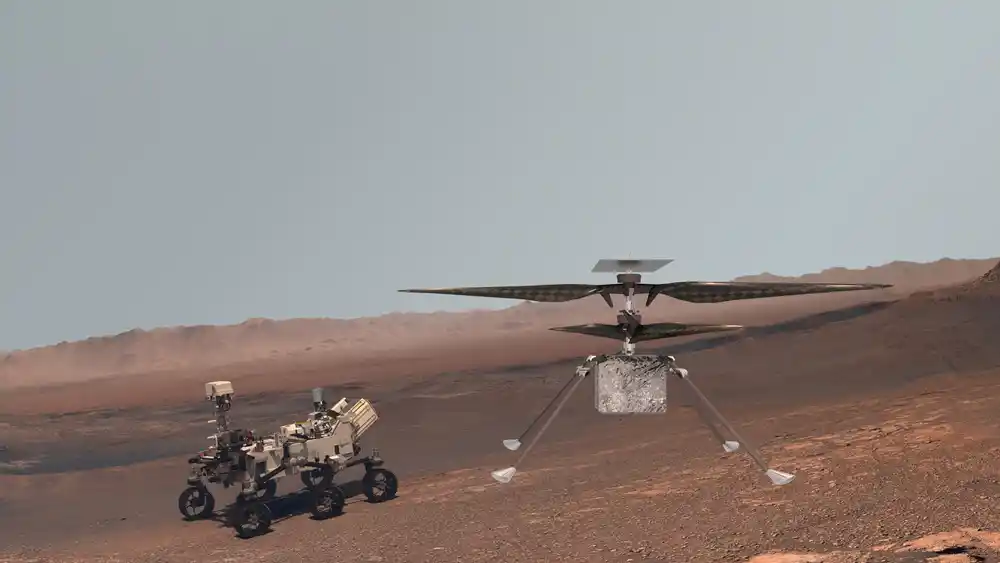
A computer-generated image of perseverance and ingenuity on mars.
The Journey
Just after launch, the spacecraft separated from the rocket. The spacecraft traveled at a speed of ~24,600 miles per hour (~39,600 kilometers per hour) and traveled ~300 million miles (~480 million kilometers). The journey took ~204 days, and during this time engineers adjusted the spacecraft’s flight path 5 times to ensure its speed and direction were optimized for a Jezero Crater landing.
On August 14, 2020 (15 days after launch) the spacecraft was pointed toward Mars and its flight plan was fine-tuned. On Sept 30, 2020 (62 days after launch), Dec 18, 2020 (62 days before landing), Feb 10, 2021 (8.6 days before landing) and Feb 16, 2021 (2.6 days before landing) the spacecraft’s flight was refined.
The landing
Entry, descent and landing (EDL) began when the spacecraft reached the top of the Martian atmosphere and ended ~7 min later when Perseverance was stationary on the surface of Mars. Mars’ atmosphere is 6.7 miles (10.8 km thick) and over 100 times thinner than Earth’s.
The spacecraft was traveling at ~12,500 miles per hour (~20,000 kilometers per hour) at the top of the atmosphere. It takes more than 11 minutes to get a radio signal back from Mars, so Perseverance was designed to complete the entire EDL process autonomously.
Ten minutes before entering the atmosphere the spacecraft shed it’s solar panels, radio and fuel tanks. Moments before entering the atmosphere the vehicle fired thrusters on the backshell and reoriented itself with the heat shield facing forward.
When the spacecraft entered the Martian atmosphere drag slowed it down and heated it up. Small thrusters fired to compensate for changes in air density that might otherwise cause the spacecraft to go off course. When the spacecraft slowed to ~940 miles per hour (~1512 kilometers per hour) (~240 seconds after entry) the supersonic parachute was deployed.
The supersonic parachute is 70.5 feet (21.5 meters) in diameter and slows the spacecraft down to 200 miles per hour (320 km per hour).
Twenty seconds after the parachute was deployed, the heat shield separated from the spacecraft and the rover was exposed to the Martian atmosphere. Perseverance used its cameras and other instruments to compare surface features to its onboard maps.
Once Perseverance determined its heading and reached an altitude of 6,900 feet (2,100 meters) it released the parachute and activated its rocket-powered descent stage.
This jet pack has eight engines pointed at the ground and slowed the vehicle to 1.7 miles per hour (2.7 kilometers per hour). At ~66 feet (~20 m) above the ground and ~12 seconds before touchdown, the descent stages lowered the Rover down to the surface using a set of 21 feet (6.4 m) long cables.
This is called the “sky crane maneuver”. While being lowered to the ground, Perseverance deployed its legs and wheels into landing position.
The moment that Perseverance sensed that its wheels touched the ground, it cut the cables to the descent stage and the descent stage flew off to make its own uncontrolled landing a safe distance away.
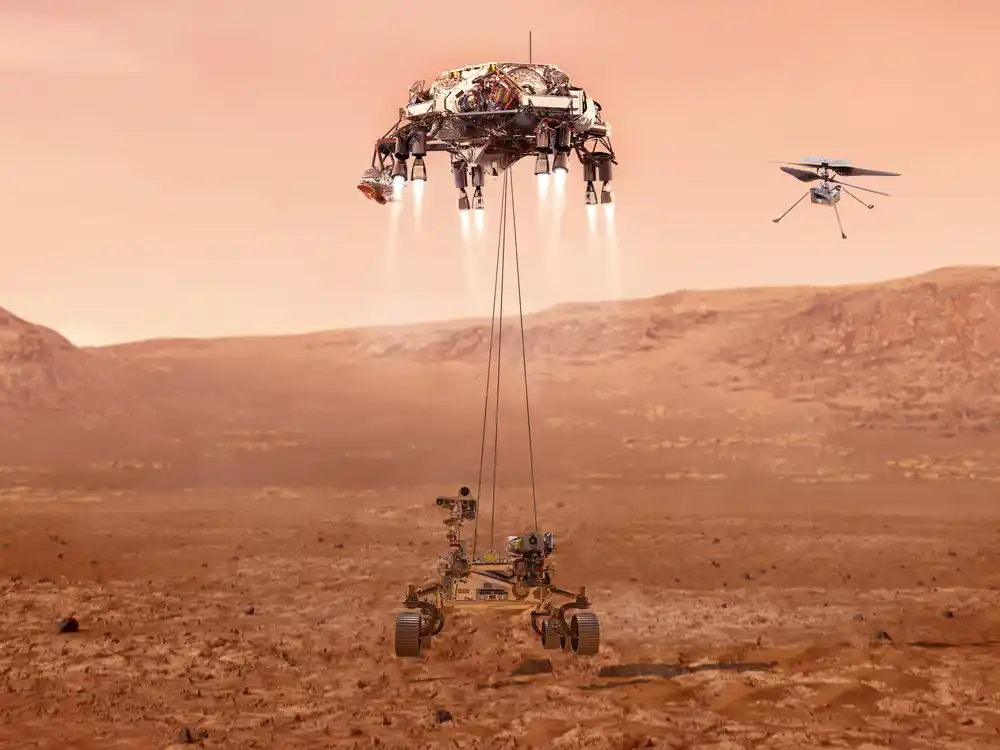
Artist rendition of perseverance's landing on mars. Note: The helicopter was still inside the rover at this time.
The Mission
Perseverance was launched July 30, 2020 and landed at Jezero Crater, Mars, on Feb 18, 2021. That’s a total travel time of ~204 days or 6 months and 20 days, or ~7 months, or ~4896 hours.
Perseverance’s mission includes studying the habitability of Mars, looking for signs of past microbial life, collecting and storing selected rock and soil samples and preparing for future human missions.
It’s mission includes a technology demonstration; Ingenuity, The Mars Helicopter. Ingenuity is a 9.3-inch-tall (49-centimeter-tall) and 4-pound (1.8 kg) rotorcraft. It completed three successful flights on Mars and this was the first time powered, controlled flight was tested on another world.
During the first successful flight, on April 19, 2021, Ingenuity took off, climbed to about 10 feet (3 meters) above the ground, hovered in the air briefly, completed a turn, and then landed. This initial flight lasted 39.1 seconds.

Written by Tanya C. Forde
Hi! I’m Tanya C. Forde, MSc (earth sciences). I was raised under the dark sky of rural Alberta and have been fascinated by astronomy since childhood. I began my exploration of the night sky with naked-eye viewing before moving on to binoculars and then telescope ownership. I also write for Sewn By Tanya.
Wow! There's more to read 🚀
This page is part of our collection of articles about astronomy. If you enjoyed the read, then you’ll love the following articles.
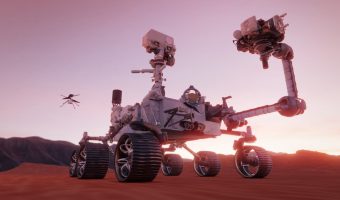
There are 3 rovers and 1 lander exploring and studying Mars inch by inch. These robotic vehicles are a vital part of space exploration.
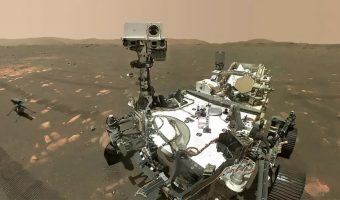
The Perseverance rover is equipped with new technology in order to carry out experiments. Let’s have a look at some of these technological innovations.

Let’s take a closer look at the closest planet to the Sun. And as you might expect, it is one of the hottest places in our solar system.
